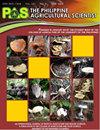自动滴灌。基于土壤电导率的系统
IF 0.4
4区 农林科学
Q4 AGRICULTURE, MULTIDISCIPLINARY
引用次数: 10
摘要
我们评估了自动灌溉控制器的灌溉性能。在这项研究中,滴灌系统根据基质-植物系统的用水量自动控制灌溉。数据采集由一个电子电路完成,该电路对数据进行处理,然后将数据发送给微控制器(可编程集成电路pic16f84)。pic16f84作为控制器,决定何时浇水和浇水多少;因此,泵根据微控制器定义的灌溉策略运行和停止。根据灌溉方案抽水所需的时间对应于在试验中,当基质中30%的有效水分被辣椒植株耗尽时,充分处理时将土壤水分增加到田间容量所需的时间。因此,一旦定义,微控制器利用数据并控制连接到泵的继电器。在整个试验过程中,仅在一个有代表性的花盆中安装一个传感器来监测土壤含水量。自动化系统适用于四种不同的水应用;一组是满的,另外三组是缺的。并与对照处理进行比较。自动化系统将土壤水分水平维持在所需的水平以进行整个处理,并接管灌溉事件,在整个生长季节开始和停止灌溉。处理I1.0产量较高,但以处理I0.75为最佳品质参数。在亏缺处理I0.50和I0.25中,由于植株受到胁迫,产量和品质参数下降。自动化系统的性能可以根据充分灌溉的应用调整软件中的时间来提高。关键词:自动灌溉,灌溉控制器,土壤湿度传感器本文章由计算机程序翻译,如有差异,请以英文原文为准。
An Automated Drip Irrigation. System Based on Soil Electrical Conductivity
We assessed the irrigation performance of the automated irrigation controller. In the study, a drip irrigation system automatically governed irrigation in accordance with water consumption of the substrate-plant system. Data acquisition was performed by an electronic circuit, which processed data and then sent the data to the microcontroller (programmable integrated circuit-pic16f84). The pic16f84 functioned as a controller, which decided when and how much water to apply; hence, the pumps ran and stopped according to the irrigation strategy defined by the microcontroller. The required time to pump water according to the irrigation programs corresponded to the time to increase soil moisture up to field capacity in the full treatment whenever 30% of the available water in the substrate was depleted by the pepper plant ( Capsicum annuum L.) in the experiment. Therefore, once defined, the microcontroller utilized the data and controlled the relays connected to the pumps. Soil moisture content was monitored by only one sensor installed in a representative pot throughout the experiment. The automated system applied four different water applications; one treatment was full and the other three were deficit treatments. These were compared with the control treatment. The automated system maintained the soil moisture level at the desired level for the full treatment and took over irrigation events, started and stopped the irrigations throughout the entire growing season. Even though yield value was high in treatment I1.0, the best quality parameters were obtained from I0.75. In the deficit treatments I0.50 and I0.25, yield and quality parameters decreased since plants in those treatments were under stress. The performance of the automated system can be increased as the time in the software is adjusted according to full irrigation application. Key Words: automated irrigation, irrigation controller, soil moisture sensor
求助全文
通过发布文献求助,成功后即可免费获取论文全文。
去求助
来源期刊

Philippine Agricultural Scientist
农林科学-农业综合
CiteScore
0.50
自引率
0.00%
发文量
67
审稿时长
>36 weeks
期刊介绍:
Philippine Agricultural Scientist (ISSN 0031-7454), an international journal of tropical agriculture and related sciences, is published quarterly by the College of Agriculture and Food Science, University of the Philippines Los Baños, 4031 College, Laguna, Philippines. Articles may be papers and notes on original fundamental or applied research and, to a limited extent, critical research reviews, professorial chair lectures or book reviews on tropical agricultural science and related areas including environmental science, food science, engineering, biotechnology, economics, extension, rural sociology, development communication, agroforestry and silviculture and marine and fishery sciences.
 求助内容:
求助内容: 应助结果提醒方式:
应助结果提醒方式:


